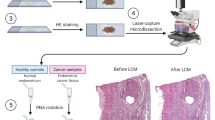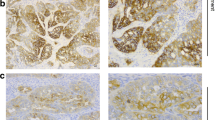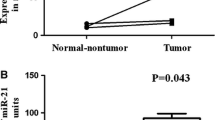Abstract
Endometrial carcinoma is one of the most common gynecological cancers. MicroRNA-21 (miR-21) is the most consistently overexpressed miRNA in almost all human cancer types, and it might be a useful clinical biomarker and therapeutic target. However, its precise localization and significance in endometrial carcinoma have not been clarified. This study aimed to examine miR-21 expression in endometrial carcinoma and reveal its clinicopathological importance. We investigated miR-21 expression by in situ hybridization (ISH) using locked nucleic acid (LNA)-modified probes in 230 endometrial carcinoma patients. We evaluated miR-21 expression in cancer cells and stroma separately. High miR-21 expression in cancer cells was significantly associated with higher histological grade and lymph node metastasis. In Kaplan–Meier analysis, high miR-21 expression in cancer cells was significantly associated with poor progression-free survival. In particular, in endometrioid carcinoma, high miR-21 expression in cancer cells was an independent prognostic factor associated with poor progression-free survival, as well as older age and higher International Federation of Gynecology and Obstetrics (FIGO) stage.



Similar content being viewed by others
References
Jemal A, Bray F, Center MM et al (2011) Global cancer statistics. CA Cancer J Clin 61:69–90
WHO Classification of Tumours Editorial Board (2020) Female Genital Tumours (WHO Classification of Tumours). IARC Press, Lyon
Bokhman JV (1983) Two pathogenetic types of endometrial carcinoma. Gynecol Oncol 15:10–17
Croce CM (2009) Causes and consequences of microRNA dysregulation in cancer. Nat Rev Genet 10:704–714
Bautista-Sánchez D, Arriaga-Canon C, Pedroza-Torres A et al (2020) The promising role of miR-21 as a cancer biomarker and its importance in RNA-based therapeutics. Mol Ther Nucleic Acids 20:409–420
Hermansen SK, Dahlrot RH, Nielsen BS, Hansen S, Kristensen BW (2013) MiR-21 expression in the tumor cell compartment holds unfavorable prognostic value in gliomas. J Neurooncol 111:71–81
Dillhoff M, Liu J, Frankel W, Croce C, Bloomston M (2008) MicroRNA-21 is overexpressed in pancreatic cancer and a potential predictor of survival. J Gastrointest Surg 12:2171–2176
Yamamichi N, Shimomura R, Inada K et al (2009) Locked nucleic acid in situ hybridization analysis of miR-21 expression during colorectal cancer development. Clin Cancer Res 15:4009–4016
Rask L, Balslev E, Jorgensen S et al (2011) High expression of miR-21 in tumor stroma correlates with increased cancer cell proliferation in human breast cancer. APMIS 119:663–673
Wang Y, Li J, Tong L et al (2013) The prognostic value of miR-21 and miR-155 in non-small-cell lung cancer: a meta-analysis. Jpn J Clin Oncol 43:813–820
Wang Y, Zhou S, Fan K, Jiang C (2019) MicroRNA-21 and its impact on signaling pathways in cervical cancer. Oncol Lett 17:3066–3070
Qin X, Yan L, Zhao X, Li C, Fu Y (2012) microRNA-21 overexpression contributes to cell proliferation by targeting PTEN in endometrioid endometrial cancer. Oncol Lett 4:1290–1296
Zhao W, Geng P, Li Y, Wei X, Cheng J (2017) MicroRNA-21 promotes endometrial carcinoma proliferation and invasion by targeting PTEN. Int J Clin Exp Pathol 10:11489–11495
Gao Y, Dai M, Liu H et al (2016) Diagnostic value of circulating miR-21: an update meta-analysis in various cancers and validation in endometrial cancer. Oncotarget 7:68894–68908
Wang C, Li Q, He Y (2020) MicroRNA-21-5p promotes epithelial to mesenchymal transition by targeting SRY-box 17 in endometrial cancer. Oncol Rep 43:1897–1905
Eriksen AH, Andersen RF, Nielsen BS et al (2016) Intratumoral heterogeneity of microRNA expression in rectal cancer. PLoS One 11:e0156919
Zedan AH, Blavnsfeldt SG, Hansen TF et al (2017) Heterogeneity of miRNA expression in localized prostate cancer with clinicopathological correlations. PLoS One 12:e0179113
Chen C, Ridzon DA, Broomer AJ et al (2005) Real-time quantification of microRNAs by stem-loop RT-PCR. Nucleic Acids Res 33:e179
Cao Z, Yoon JH, Nam SW, Lee JY, Park WS (2012) PDCD4 expression inversely correlated with miR-21 levels in gastric cancers. J Cancer Res Clin Oncol 138:611–619
Peltier HJ, Latham GJ (2008) Normalization of microRNA expression levels in quantitative RT-PCR assays: identification of suitable reference RNA targets in normal and cancerous human solid tissues. RNA 14:844–852
Viera AJ, Garrett JM (2005) Understanding interobserver agreement: the kappa statistic. Fam Med 37:360–363
McHugh ML (2012) Interrater reliability: the kappa statistic. Biochem Med (Zagreb) 22:276–282
Kadera BE, Li L, Toste PA et al (2013) MicroRNA-21 in pancreatic ductal adenocarcinoma tumor-associated fibroblasts promotes metastasis. PLoS One 8:e71978
Uozaki H, Morita S, Kumagai A et al (2014) Stromal miR-21 is more important than miR-21 of tumour cells for the progression of gastric cancer. Histopathology 65:775–783
Acknowledgements
The authors thank Ms. Chinami Onuma, Asumi Tsutsumi, MT, and Ru Hokari, MT for their excellent technical assistance, and Editage (www.editage.jp) for English language editing.
Author information
Authors and Affiliations
Contributions
Kimiya Sato, Morikazu Miyamoto, Masashi Takano, and Hitoshi Tsuda conceived and designed the study. Kimiya Sato and Hitoshi Tsuda conducted the research, analyzed data, and drafted the manuscript. All authors reviewed the manuscript and gave final approval for publication. Kimiya Sato takes full responsibility for the work as a whole, including the study design, access to data, and the decision to submit and publish the manuscript.
Corresponding author
Ethics declarations
Ethics approval
The research protocol was approved by the Institutional Ethical Review Board Committee of the National Defense Medical College, Tokorozawa, Japan (Reference No. 3004).
Conflict of interest
The authors declare no competing interests.
Additional information
Publisher's note
Springer Nature remains neutral with regard to jurisdictional claims in published maps and institutional affiliations.
Rights and permissions
About this article
Cite this article
Sato, K., Miyamoto, M., Takano, M. et al. MicroRNA-21 expression in cancer cells is an independent biomarker of progression-free survival of endometrioid endometrial carcinoma. Virchows Arch 479, 883–891 (2021). https://doi.org/10.1007/s00428-021-03171-w
Received:
Revised:
Accepted:
Published:
Issue Date:
DOI: https://doi.org/10.1007/s00428-021-03171-w




